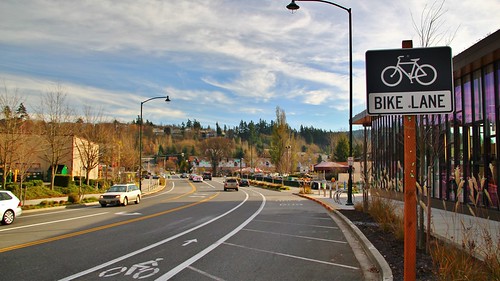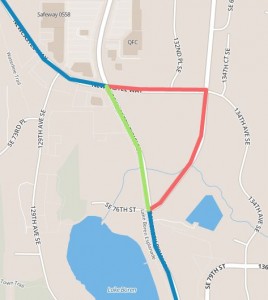A map of frequent service to and from Factoria. The thick red line is the frequent corridor shared by routes 240 and 241 and the thick blue line is the peak-only frequent corridor shared by routes 114 and 240. The purple, green and orange lines represent the less-frequent portions of routes 114, 240 and 241, respectively.
When we wrote about how to implement frequent service in Factoria, we envisioned a likely yes vote on Proposition 1. However with the failure of the proposition, this vision will be impacted.
The cuts
All of the routes involved with the frequent service are getting cut in some way. Here’s how:
- The 114 will be reduced to 3 trips in either direction, instead of 5 inbound and 4 outbound.
- The 210 will be entirely deleted. This should not be a surprise as the only real source of ridership for the route is at Eastgate Park and Ride.
- The 240 will end service at 9pm instead of 11pm.
- The 241 will be cut to hourly midday and Saturdays.
The impact on the frequent service
- The frequent service corridors for the 114/210 between Factoria and Downtown Seattle and the 210/240 in Eastgate will be deleted.
- The frequent service corridor for the 114 and 240 in Newport Hills and Newcastle will loose service span.
- The frequent service corridor for the 240 and 241 between Factoria and Downtown Bellevue will be kept (see below).
How to maintain frequent service
Since the 241 is slated to be cut to hourly middays and Saturdays, a series of improvements in service efficiency will have to be made in order to keep the 241 running half-hourly during those periods. This means that a lot of reroutes will have to be made:
The reroute of the 241 off 108th Ave NE will save up to three minutes per trip outbound and five inbound, while improving the quality of service with no speed bumps and the elimination of the three turns required to reach Bellevue TC.
The big reroute of the 240 to reach Bellevue via Bellevue Way and 112th Ave SE instead of detouring to Eastgate Park-and-ride will save anywhere between 8 and 15 minutes per trip, depending on the time of the day. Those savings will reduce the length of the route (in time) by as much as 20%, allowing for slightly shorter layover times. Currently, the 240 has an extra-long 25-minute layover at each end of the route. It seems reasonable to cut those layover to 15-17 minutes considering the fact that the route is shorter. Combined with the shorter layover, the reroute would allow for each bus to basically run one bus earlier than currently for each turnback.

Another issue is routing in Newcastle. Currently buses come from Newcastle way (behind the photographer in the photo) then pull over into the bus stop, which is designed to have the bike lane away from it. The bus lane then becomes the right-turn lane onto Coal Creek Parkway. The buses eventually end-up running on Coal Creek parkway but not after making a detour which requires them to go straight at the above intersection, make an awkward right-turn at the top of the hill then enter Coal Creek Parkway via a left turn at a long light. This design creates conflict between the buses that must pull back into the middle lane to go straight, the cars that turn right and the bikes which have buses crossing into the lane twice.
The solution would see the buses take the right turn into Coal Creek directly, saving a couple minutes per trip. This makes more sense with the map shown below.

In the original post, it was mentioned that the 114 would need to be rerouted all the way to Eastgate Park and Ride via Factoria. Due to the funding shortfall it would only be rerouted to Factoria (to replace the 210 as the peak-only route to Downtown Seattle), but not to Eastgate Park and Ride.
So what does this all do?
- The hours saved by rerouting the 241 off 108th Ave NE would accumulate as the day goes on, and provide additional trips to restore some mid-day service.
- The 240’s huge time savings would mostly be spent on adding trips to the 241 to keep half-hourly mid-day and Saturday service, although some savings would be used to keep the 240 running until 11pm. This restores service on routes 240 and 241 to their current levels.
- The small time savings of the Newcastle detour would allow the 114 to detour off to Factoria without requiring more time on the run.
If the 240’s re-route proves to be very successful and saves more revenue hours than expected, it could be spent on adding a fourth trip to route 114, thus keeping the 15-minute peak-only service south of Factoria for longer.
Guy is a high school student in Bellevue with a strong desire to become an urban planner. Before moving to Bellevue, he grew up in the Paris metropolitan area where he fell in love with and learned from some of the best rail systems in Europe. Translating his experiences from abroad to Seattle, Guy is now passionate about improving this region's public transit (especially marine-based transportation) and cycling infrastructure. Aside from the technical side of things, Guy also enjoys photography and music.

